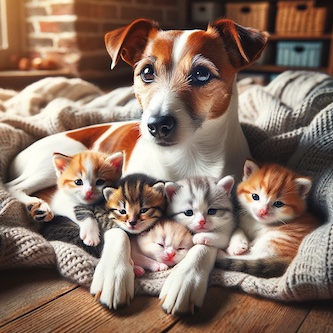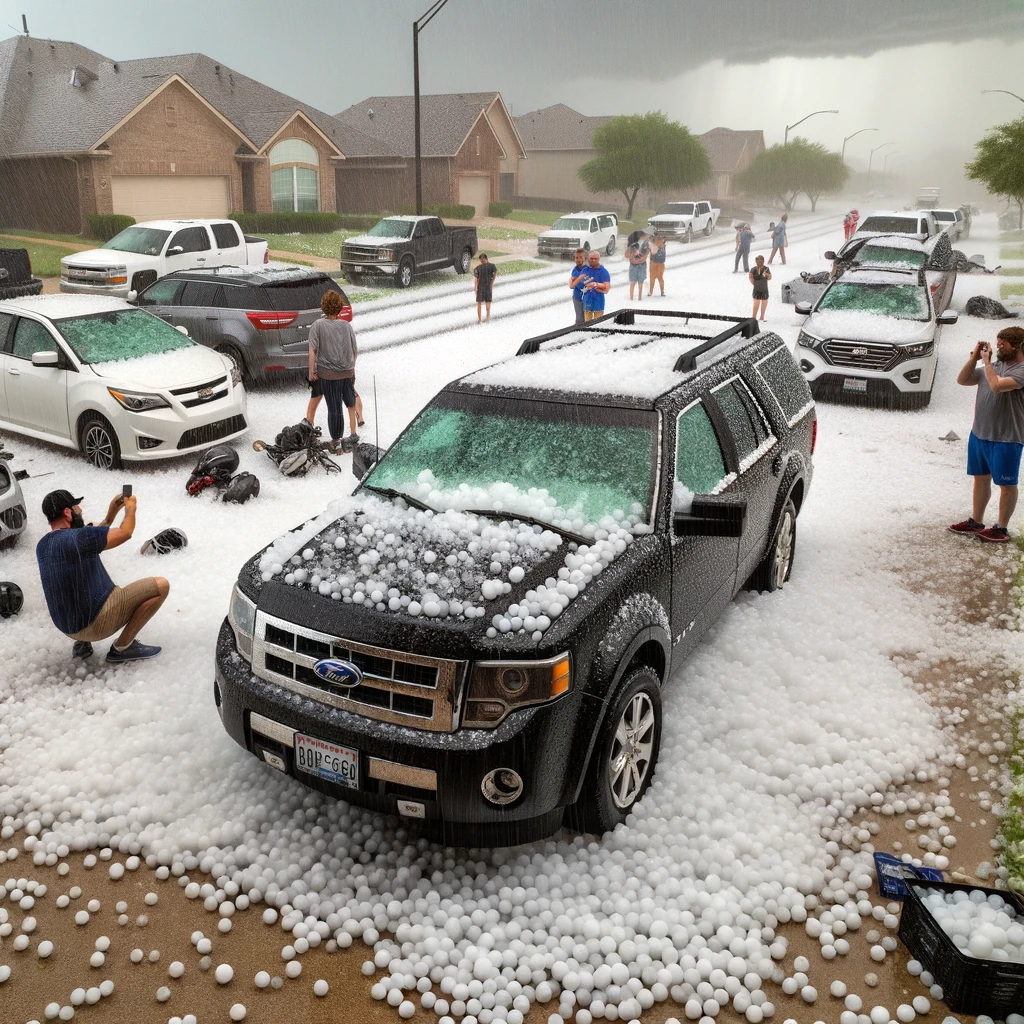In Newmarket, there’s a sweet story about a dog named Teasel who took care of a group of abandoned kittens. Teasel’s owner, Sue Stubley, planned to look after the kittens for one night before taking them to a cat rescue. But Teasel started caring for the kittens, even making milk for them.
Teasel didn’t just feed and clean the kittens, she also protected them. She would pick up any stray kittens and put them back in their bed. It’s not that strange for a dog to take care of kittens, as there have been cases of cats and dogs looking after each other’s babies.
A biologist named Dr. Rachel Grant explained that when animals from different species take care of each other’s young, it’s because of “fixed action patterns.” These patterns make the adopting animal respond to certain signals from the adoptee, which triggers them to care for the babies. Dr. Grant also said that the more similar two species are, the more likely they are to take care of each other’s young.
Even though it’s heartwarming to see animals from different species taking care of each other, it makes us think about evolution. Dr. Grant said that these behaviors are driven by instinct and specific signals, which aren’t under conscious control. But as long as these behaviors work most of the time, they’re likely to be chosen by evolution.
After the kittens are done nursing, they might not be as close to Teasel. But all the kittens have new families waiting to take them home, and Teasel’s strong motherly instincts will help her if she has puppies in the future.
Original news source: Why did a dog in Newmarket end up nursing a litter of kittens? (BBC)
Listen
Slow
Normal
Fast
Group or Classroom Activities
Warm-up Activities:
– Headline Creation
Instructions: Students must create their own catchy headlines for the story they just read. Encourage creativity and lesson-related vocabulary usage. After crafting their headlines, they can share with the class and explain why they chose those words.
– Sketch It
Instructions: In pairs or small groups, students are given a segment of the article to illustrate in a quick sketch. For example, one group could draw Teasel caring for the kittens, while another could illustrate the concept of “fixed action patterns”. Afterward, they explain their drawings to the class, using vocabulary from the article.
– Opinion Spectrum
Instructions: Place a line in the classroom from ‘Strongly Agree’ to ‘Strongly Disagree’. Read out statements related to the article (e.g., “Animals have emotions similar to humans” or “Instincts are more powerful than learned behaviors”) and have students position themselves along the spectrum according to their opinion. They must then discuss their position with the nearest classmate.
– Speed Summarizing
Instructions: Pair students up and challenge them to summarize the article to their partner in under one minute. They should focus on including the main points and any new vocabulary they learned. Afterward, they switch roles.
– Future Predictions
Instructions: Have students discuss or write about what they think will happen to the kittens and Teasel in the future. Encourage them to use modal verbs of probability (e.g., might, could, will) as they make predictions based on the information from the article. They can share their thoughts with a partner or with the whole class.
Comprehension Questions:
1. What did Teasel do for the group of abandoned kittens in Newmarket?
2. What was Sue Stubley’s original plan for the kittens before Teasel started taking care of them?
3. Besides feeding and cleaning, how else did Teasel protect the kittens?
4. What did Dr. Rachel Grant say about animals from different species caring for each other’s young?
5. How do “fixed action patterns” influence the behavior of animals like Teasel?
6. According to the article, why are certain behaviors likely to be chosen by evolution?
7. What might change about the relationship between Teasel and the kittens after they are done nursing?
8. What future benefit might Teasel gain from her experience with the kittens?
Go to answers ⇩
Listen and Fill in the Gaps:
In Newmarket, there’s a sweet story about a dog named (1)______ who took care of a group of abandoned (2)______. Teasel’s owner, Sue Stubley, (3)______ to look after the kittens for one night before (4)______ them to a cat rescue. But Teasel started caring for the kittens, even making milk for them.
Teasel didn’t just feed and clean the kittens, she also protected them. She would pick up any stray kittens and put them back in their bed. It’s not that strange for a dog to take care of kittens, as there have been cases of cats and dogs looking after each other’s (5)______.
A biologist named Dr. Rachel (6)______ explained that when (7)______ from different species take care of each other’s young, it’s because of “fixed action (8)______.” These patterns make the adopting animal respond to (9)______ signals from the adoptee, which triggers them to care for the babies. Dr. Grant also said that the more (10)______ two species are, the more likely they are to take care of each other’s young.
Even though it’s heartwarming to see animals from different species taking care of each other, it (11)______ us think about (12)______. Dr. Grant said that these behaviors are driven by instinct and specific signals, which aren’t under conscious control. But as long as these behaviors work most of the time, they’re likely to be chosen by evolution.
After the kittens are done nursing, they might not be as (13)______ to Teasel. But all the kittens have new (14)______ waiting to take them home, and Teasel’s strong motherly (15)______ will help her if she has puppies in the (16)______.
Go to answers ⇩
Discussion Questions:
Students can ask a partner these questions, or discuss them as a group.
1. What is the kindest thing you have ever seen an animal do?
2. How would you feel if you saw a dog taking care of kittens in real life?
3. Do you like stories about animals helping each other? Why or why not?
4. Have you ever seen animals from different species being friends? Tell us about it.
5. What do you think creates a bond between animals of different species?
6. Do you think animals have feelings like humans do? Why or why not?
7. If you had a pet, would you want it to be friendly with other types of animals? Why?
8. Have you ever taken care of an animal that wasn’t yours? What was that like?
9. What is a ‘fixed action pattern’ in your own words?
10. Why do you think some animals adopt babies from other species?
11. Do you think we can learn something about kindness from animals?
12. If you could have any animal as a pet, which one would you choose and why?
13. How important do you think it is for pets to have a mother figure?
14. Do you think it’s a good idea to adopt pets from shelters? Why or why not?
15. What qualities do you think make a good parent, whether it’s an animal or a human?
Individual Activities
Vocabulary Meanings:
Match each word to its meaning.
Words:
1. Teasel
2. kittens
3. abandoned
4. biologist
5. instinct
6. conscious
7. nursing
8. puppies
Meanings:
(a) A scientist who studies living things
(b) Not aware or intentional
(c) Baby cats
(d) A female dog who took care of abandoned kittens
(e) Baby dogs
(f) A natural behavior that animals are born with
(g) Left behind and unwanted
(h) Feeding a baby with milk from the mother’s body
Go to answers ⇩
Multiple Choice Questions:
1. Why did Teasel’s owner, Sue Stubley, plan to take care of the abandoned kittens for only one night?
(a) She planned to take them to a cat rescue the next day
(b) She didn’t want to keep them for long
(c) She didn’t like the kittens
(d) She was allergic to cats
2. What did Teasel do for the abandoned kittens?
(a) Took them for walks
(b) Taught them how to bark
(c) Ignored them
(d) Fed them and made milk for them
3. According to Dr. Rachel Grant, why do animals from different species take care of each other’s young?
(a) They feel lonely
(b) They want to confuse other animals
(c) Fixed action patterns
(d) They are bored
4. What did Dr. Rachel Grant say about the likelihood of animals taking care of each other’s young?
(a) The more similar two species are, the more likely they are to take care of each other’s young
(b) The more different two species are, the more likely they are to take care of each other’s young
(c) It doesn’t matter how similar or different the species are
(d) Animals never take care of each other’s young
5. What did Dr. Rachel Grant say about the behaviors of animals taking care of each other’s young?
(a) They are driven by conscious control
(b) They are random
(c) They are driven by instinct and specific signals
(d) They are not important for evolution
6. What did the article say about the future of the kittens and Teasel?
(a) The kittens will stay with Teasel forever
(b) The kittens have new families waiting to take them home and Teasel’s strong motherly instincts will help her if she has puppies in the future
(c) Teasel will take care of the kittens for the rest of their lives
(d) The kittens will be taken to a cat rescue
7. What did Teasel do when she found stray kittens?
(a) She ignored them
(b) She picked them up and put them back in their bed
(c) She barked at them
(d) She took them for a walk
8. What did Teasel do to protect the abandoned kittens?
(a) She ignored them
(b) She played with them
(c) She taught them how to bark
(d) She protected them
Go to answers ⇩
True or False Questions:
1. Teasel not only fed and cleaned the kittens but also neglected them by putting stray kittens back in their bed.
2. A dog named Teasel took care of a group of abandoned kittens in Newmarket.
3. Teasel started caring for the kittens, even making milk for them.
4. The more similar two species are, the more likely they are to take care of each other’s young.
5. Dr. Rachel Grant, a biologist, explained that when animals from different species take care of each other’s young, it’s because of “fixed action patterns.”
6. These behaviors are not driven by instinct and specific signals, which are under conscious control.
7. Teasel’s owner, Sue Stubley, did not plan to look after the kittens for one night before taking them to a cat rescue.
8. After the kittens are done nursing, they might be as close to Teasel, but not all the kittens have new families waiting to take them home.
Go to answers ⇩
Write a Summary:
Write a summary of this news article in two sentences.
Check your writing now with the best free AI for English writing!
Writing Questions:
Answer the following questions. Write as much as you can for each answer.
Check your answers with our free English writing assistant!
1. What did Teasel do when she found the abandoned kittens?
2. Why did Teasel’s owner originally plan to do with the kittens, and what changed her plan?
3. Can you explain what “fixed action patterns” are and how they relate to the story about Teasel?
4. According to Dr. Rachel Grant, what influences the behavior of animals like Teasel when they take care of young from different species?
5. What might happen to the relationship between Teasel and the kittens after they stop nursing, and what is already planned for the kittens’ future?
Answers
Comprehension Question Answers:
1. What did Teasel do for the group of abandoned kittens in Newmarket?
Teasel took care of the abandoned kittens by feeding them, cleaning them, and even making milk for them.
2. What was Sue Stubley’s original plan for the kittens before Teasel started taking care of them?
Sue Stubley’s original plan was to look after the kittens for one night before taking them to a cat rescue.
3. Besides feeding and cleaning, how else did Teasel protect the kittens?
Teasel protected the kittens by picking up any that strayed and putting them back in their bed.
4. What did Dr. Rachel Grant say about animals from different species caring for each other’s young?
Dr. Rachel Grant said that animals from different species might take care of each other’s young due to “fixed action patterns” that cause them to respond to certain signals from the adoptee, triggering them to care for the babies.
5. How do “fixed action patterns” influence the behavior of animals like Teasel?
“Fixed action patterns” are instinctual behaviors that are triggered by specific signals from the young, leading animals like Teasel to care for them.
6. According to the article, why are certain behaviors likely to be chosen by evolution?
Certain behaviors are likely to be chosen by evolution because they work most of the time and are driven by instinct, which isn’t under conscious control.
7. What might change about the relationship between Teasel and the kittens after they are done nursing?
After the kittens are done nursing, they might not be as close to Teasel as they were before.
8. What future benefit might Teasel gain from her experience with the kittens?
Teasel’s strong motherly instincts developed from caring for the kittens might help her if she has puppies in the future.
Go back to questions ⇧
Listen and Fill in the Gaps Answers:
(1) Teasel
(2) kittens
(3) planned
(4) taking
(5) babies
(6) Grant
(7) animals
(8) patterns
(9) certain
(10) similar
(11) makes
(12) evolution
(13) close
(14) families
(15) instincts
(16) future
Go back to questions ⇧
Vocabulary Meanings Answers:
1. Teasel
Answer: (d) A female dog who took care of abandoned kittens
2. kittens
Answer: (c) Baby cats
3. abandoned
Answer: (g) Left behind and unwanted
4. biologist
Answer: (a) A scientist who studies living things
5. instinct
Answer: (f) A natural behavior that animals are born with
6. conscious
Answer: (b) Not aware or intentional
7. nursing
Answer: (h) Feeding a baby with milk from the mother’s body
8. puppies
Answer: (e) Baby dogs
Go back to questions ⇧
Multiple Choice Answers:
1. Why did Teasel’s owner, Sue Stubley, plan to take care of the abandoned kittens for only one night?
Answer: (a) She planned to take them to a cat rescue the next day
2. What did Teasel do for the abandoned kittens?
Answer: (d) Fed them and made milk for them
3. According to Dr. Rachel Grant, why do animals from different species take care of each other’s young?
Answer: (c) Fixed action patterns
4. What did Dr. Rachel Grant say about the likelihood of animals taking care of each other’s young?
Answer: (a) The more similar two species are, the more likely they are to take care of each other’s young
5. What did Dr. Rachel Grant say about the behaviors of animals taking care of each other’s young?
Answer: (c) They are driven by instinct and specific signals
6. What did the article say about the future of the kittens and Teasel?
Answer: (b) The kittens have new families waiting to take them home and Teasel’s strong motherly instincts will help her if she has puppies in the future
7. What did Teasel do when she found stray kittens?
Answer: (b) She picked them up and put them back in their bed
8. What did Teasel do to protect the abandoned kittens?
Answer: (d) She protected them
Go back to questions ⇧
True or False Answers:
1. Teasel not only fed and cleaned the kittens but also neglected them by putting stray kittens back in their bed. (Answer: False)
2. A dog named Teasel took care of a group of abandoned kittens in Newmarket. (Answer: True)
3. Teasel started caring for the kittens, even making milk for them. (Answer: True)
4. The more similar two species are, the more likely they are to take care of each other’s young. (Answer: True)
5. Dr. Rachel Grant, a biologist, explained that when animals from different species take care of each other’s young, it’s because of “fixed action patterns.” (Answer: True)
6. These behaviors are not driven by instinct and specific signals, which are under conscious control. (Answer: False)
7. Teasel’s owner, Sue Stubley, did not plan to look after the kittens for one night before taking them to a cat rescue. (Answer: False)
8. After the kittens are done nursing, they might be as close to Teasel, but not all the kittens have new families waiting to take them home. (Answer: False)
Go back to questions ⇧













